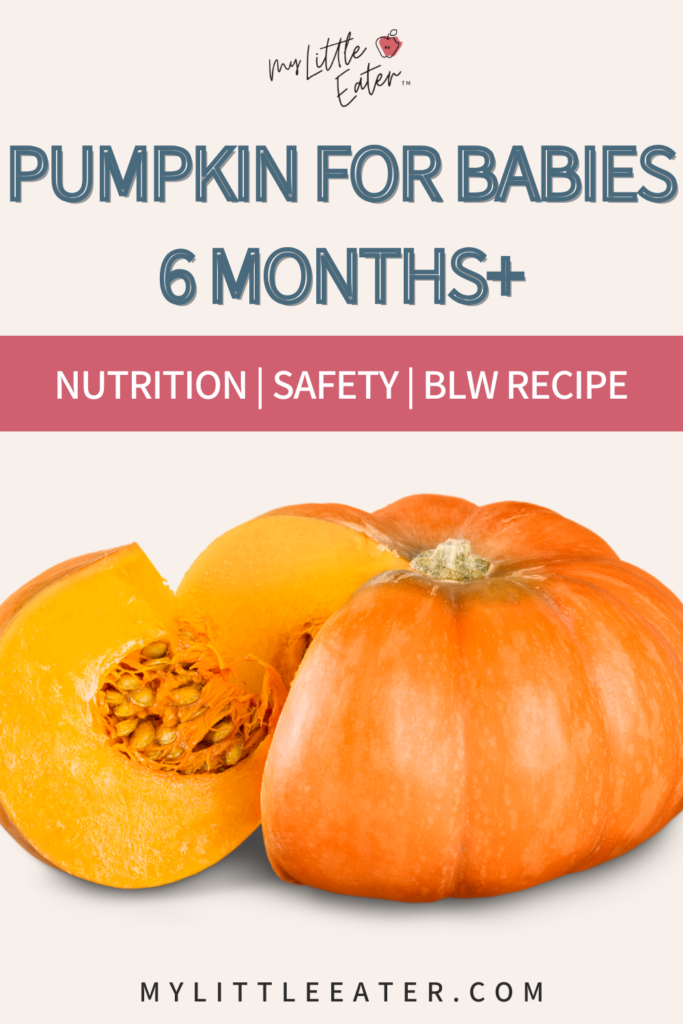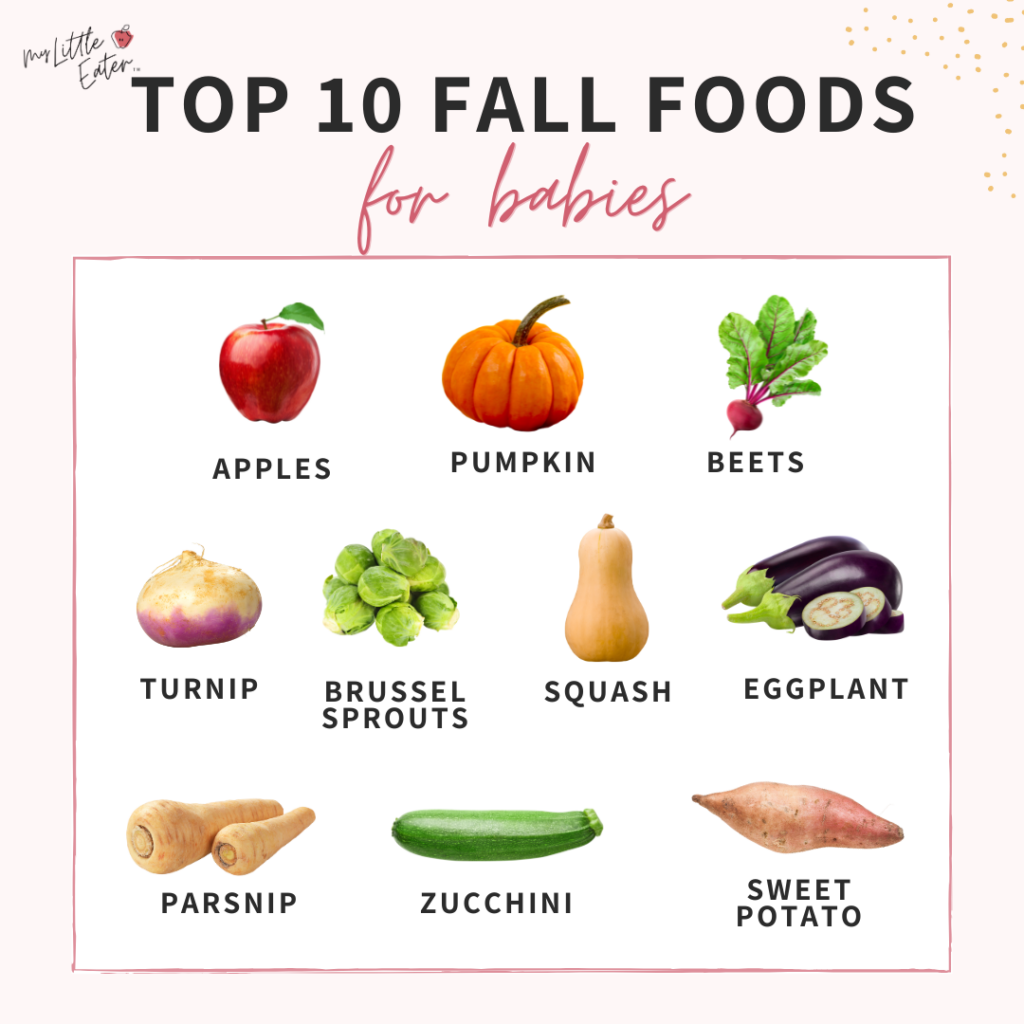This post may contain affiliate links, please view our disclosure policy for more details.
When many of us think of pumpkins, we think of carving pumpkins at Halloween! But pumpkins are good for more than just carving into jack-o’-lanterns…
Pumpkins are a type of winter squash with impressive health benefits, providing important nutrients like vitamin A and antioxidants (1). Pumpkins need to be cooked before being served to your baby, but once cooked, they can be safely served in various ways such as a purée, mashed, as pumpkin “fries”, in a disc shape, or cubes.
Table of Contents
If you prefer to listen while you multitask, download the podcast episode below!
When can babies eat pumpkins?
Pumpkins are safe for babies to consume as soon as they start solids at around 6 months of age when they’re showing all of the developmental signs of readiness. Because pumpkin can be prepared in a variety of ways, you can choose to serve it as a puree or finger food, depending on what you feel comfortable starting with.
How to serve pumpkin according to the Texture Timeline™
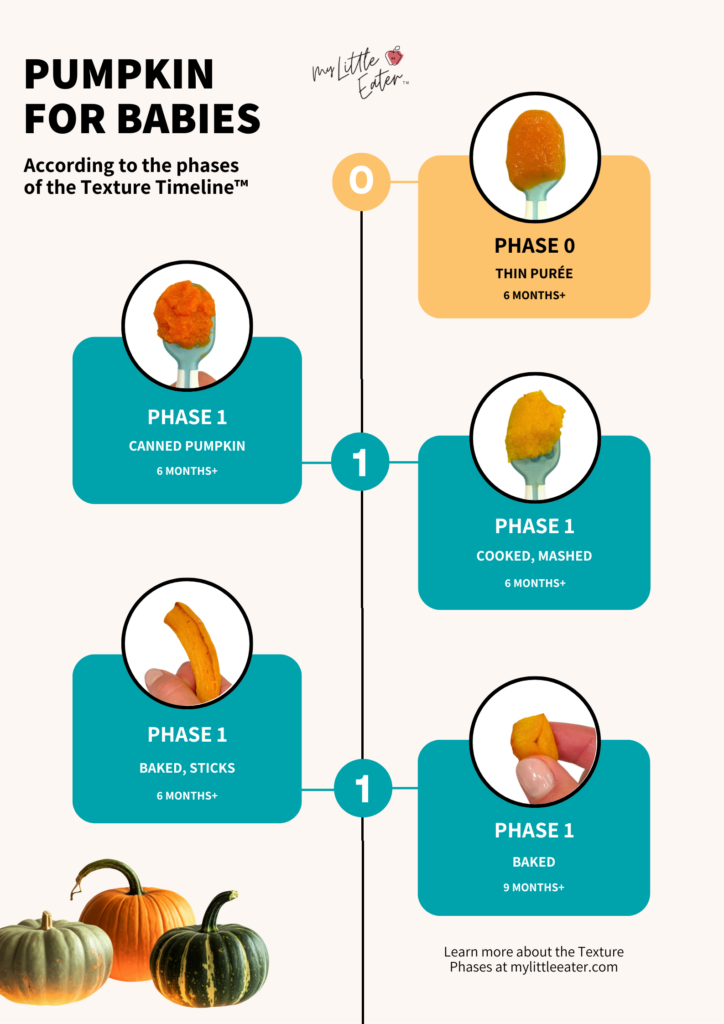
These are the safest, suggested ways to serve food to your baby based on the scientific, developmental, and clinical research and expertise available to date and are vetted by pediatric doctors, speech-language pathologists, and dietitians. However, please note that babies can technically choke on anything, including purees. Always take into account your child’s individual abilities and needs and check with your doctor or feeding therapist on the safety of offering these foods to your baby. Be mindful of how to set up a safe eating environment and please know that all material, opinions, advice, and information found on mylittleeater.com is for informational and educational purposes only. See our disclaimer for more information.
What is the Texture Timeline™?
A tool exclusive to My Little Eater that allows you to start solids with your baby using purées, finger foods, or a mixture of both. We sort all foods into different phases of the timeline based on texture difficulty, presenting multiple ways to serve each food depending on what you and your baby are ready for.
You can start with any phase of the Texture Timeline™. The goal is to always be moving forward on the timeline so that you can advance your baby to more challenging textures in a timely manner. This will allow your baby to develop and practice new eating skills and ensure that they don’t stay stuck on one texture for too long.
Using the Texture Timeline™ can help to prevent picky eating, all while keeping the feeding process enjoyable and less stressful for you because you can ease into the difficult textures that often cause more anxiety and worry.
Texture Timeline Phase 0
Thin puree (Utensils)

Thin out canned pumpkin puree with a bit of water, breast milk, or formula to create a smooth puree. Alternatively, if you have access to a fresh pumpkin, you can blend cooked pieces of pumpkin along with water, breast milk, or formula.
Whether you’re using canned or fresh pumpkin, the finished puree should be thin enough that it drips off of a spoon when tilted. Serve the thin pumpkin puree to your baby on a preloaded spoon.
Texture Timeline Phase 1
Option 1: Canned pumpkin puree (Utensils)
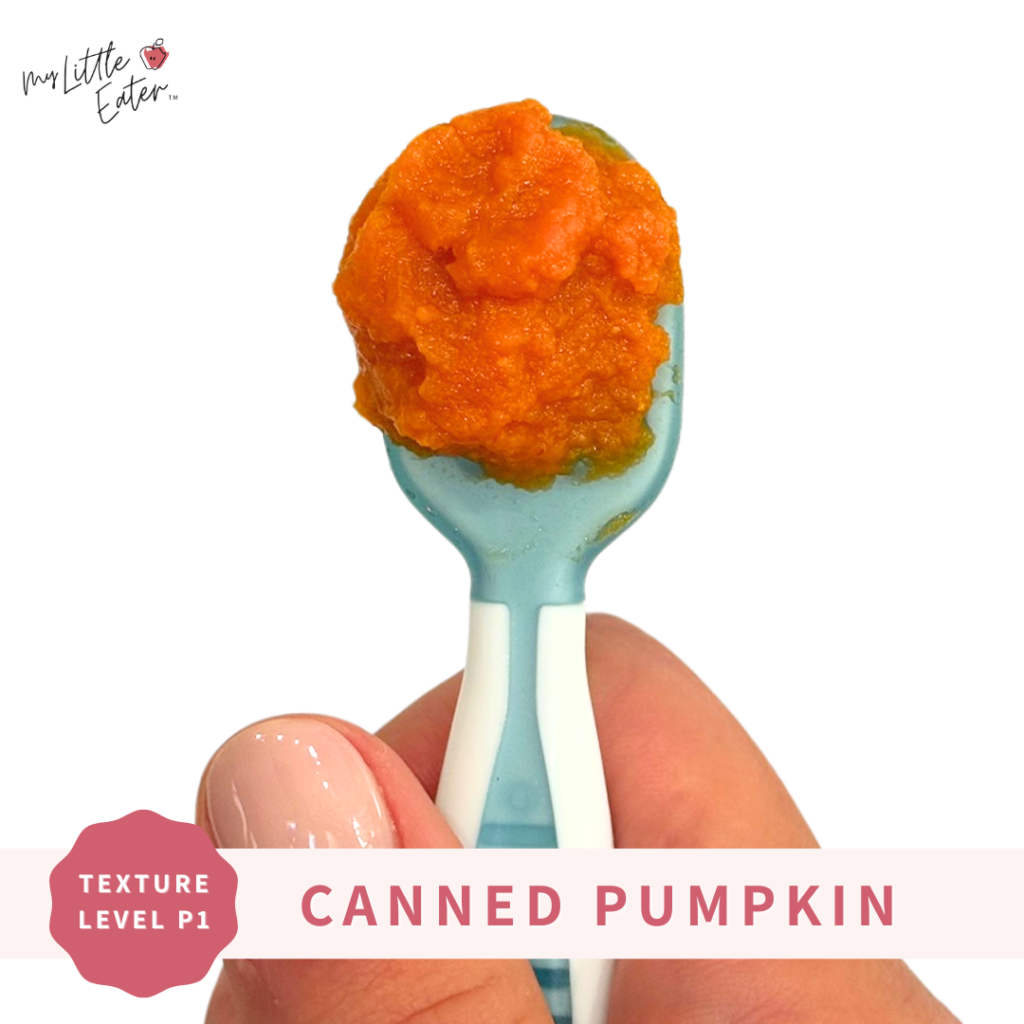
Canned pumpkin puree is naturally a thick, smooth puree, and falls into the category of a phase 1 texture. You can serve canned pumpkin to your baby as is, or if you have access to a fresh pumpkin, you can blend cooked pieces of pumpkin until you achieve a thick pureed texture. You can use a bit of water, breast milk, or formula to help with the blending process as needed.
Serve the thick puree to your baby on a preloaded spoon. Or, if they’re not interested in eating from a spoon, you can let them dig in with their hands!
Texture Timeline Phase 1
Option 2: Cooked, mashed (Utensils)
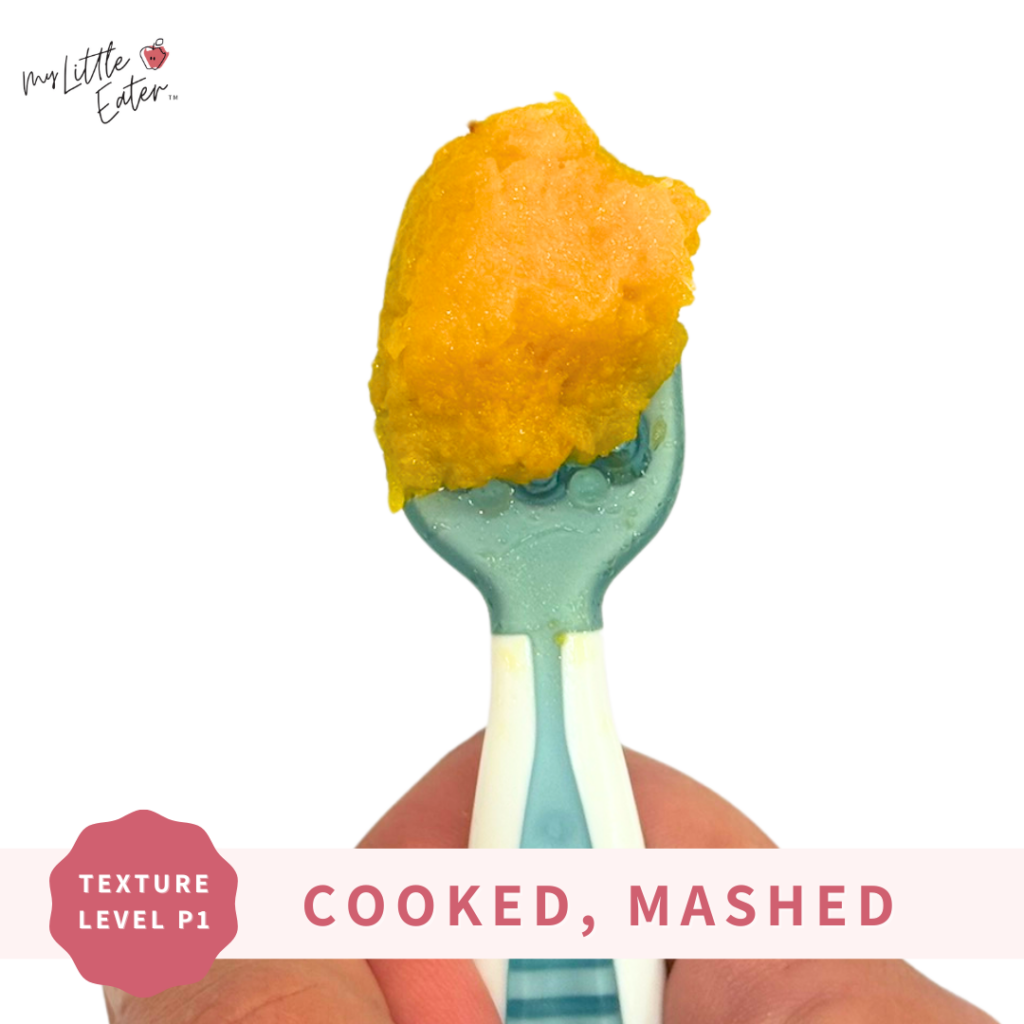
Cook a pumpkin until soft (this can be done by boiling, steaming, or baking), then mash the cooked pumpkin into a lumpy puree using a potato masher or the back of a fork.
There’s no need to mash until completely smooth – some small lumps and bumps are ok in phase 1! Serve to your baby on a preloaded spoon.
Texture Timeline Phase 1
Option 3: Baked, sticks/Bite-sized pieces (Palmar/Pincer grasp)
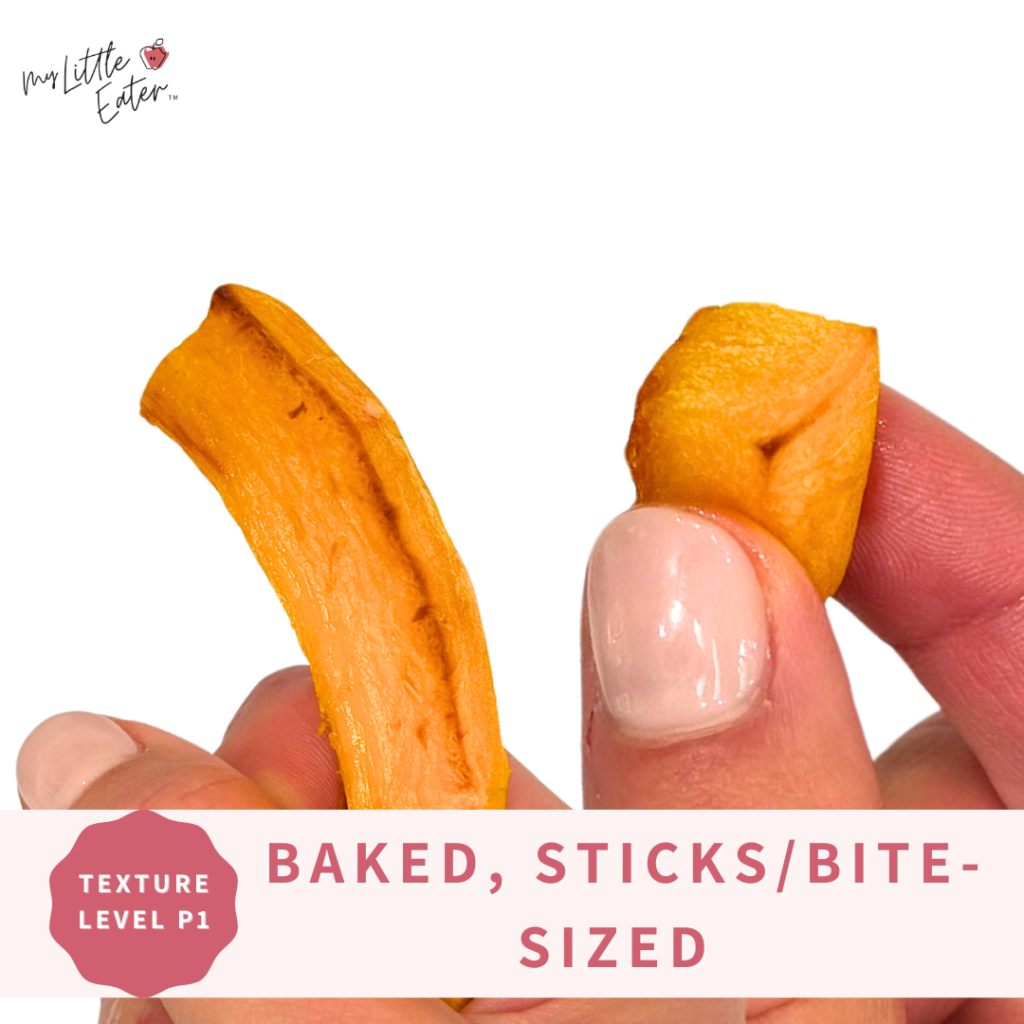
Step 1: Place a washed pumpkin on a cutting board, then use a sharp knife to cut a round circle around the stem (the circle should be larger in size than your fist).
Step 2: Once you’ve cut a complete circle, grab hold of the stem and pull it upwards to remove the round circle that you cut from the rest of the pumpkin.
Step 3: Use a large spoon to scoop out all of the seeds and stringy bits from the inside of the pumpkin until it’s hollowed out.
Step 4: Use a sharp knife or a vegetable peeler to remove the thick outer skin from the flesh of the pumpkin, then cut the flesh in half, lengthwise. Place each half inside facing down onto the cutting board, then cut into strips about 1 inch thick. Cut each strip in half lengthwise until you’re left with sticks that are about 1 inch wide and 3 inches long.
Step 5: Place the pumpkin pieces into a large bowl. Drizzle liberally with a healthy fat like olive oil or avocado oil, then season with spices or herbs like paprika, garlic powder, or curry powder! Just remember to avoid added salt and sugar.
Step 6: Evenly spread out the pieces of pumpkin onto a lined sheet pan. Don’t overcrowd the pan and keep the pieces in one layer so that they cook evenly. Roast for 25-30 minutes at 400°F or until soft and easy to mash between your fingers.
Step 7: Once cooled. serve to your baby for them to pick up and hold using their palmar grasp.
If your baby has their pincer grasp, you can cut the pumpkin into bite-sized pieces. To cook the pumpkin, follow the steps above. However, dice each strip into small, bite-sized pieces (about ½-1 inch in size), and roast for about 20 minutes at 400°F or until soft and easy to mash between your fingers. Allow the pieces to cool, then serve to your baby for them to pick up and hold using their pincer grasp.
Baby Nico eating pieces
of cooked pumpkin!
Baby Nico eating pieces of cooked pumpkin!
Nico is about 6.5 months old here and is trying pumpkin for the first time as a finger food.
Is pumpkin a choking hazard for babies?
Pumpkin is not a common choking hazard for babies. When pumpkin is cooked, it turns into a very soft texture that’s easy to chew and swallow. Follow our instructions below for cooking pumpkin to ensure it comes out soft enough for your baby to eat, or to make into a puree.
Always make sure you’re offering your baby appropriate foods based on their skill level and ability to chew their food thoroughly.
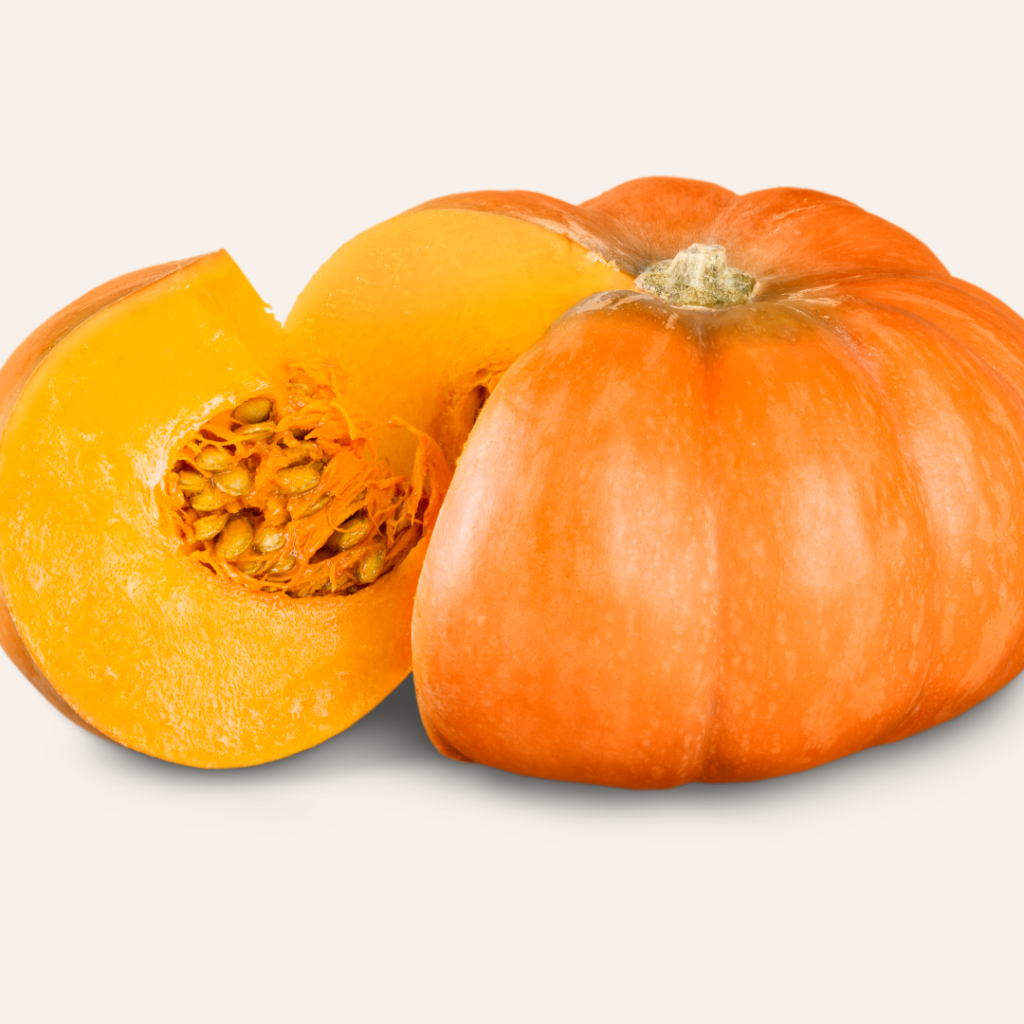
Choosing the best pumpkin for baby
Most of us are used to going pumpkin picking to get the most aesthetically pleasing pumpkin or one that will be easiest to carve, etc. But how do you choose which pumpkin is best for eating and are there certain types of pumpkins that are better than others?
When it comes to cooking and baking with pumpkin, you typically want to buy a smaller pumpkin, like a pie pumpkin (sometimes called a sugar pumpkin). These tend to have the most rich flavor, and they’re easier to cook due to their small size (2).
While they might be harder to carve into (they have thicker walls so there’s more flesh to cook with) than a carving pumpkin which is typically grown to be more hollow with thin walls, the seeds are easier to clean out (2).
Additionally, the flesh of a pie pumpkin tends to be sweeter with more flavor as compared to a carving pumpkin which has more watery flesh that produces less flavor (2).
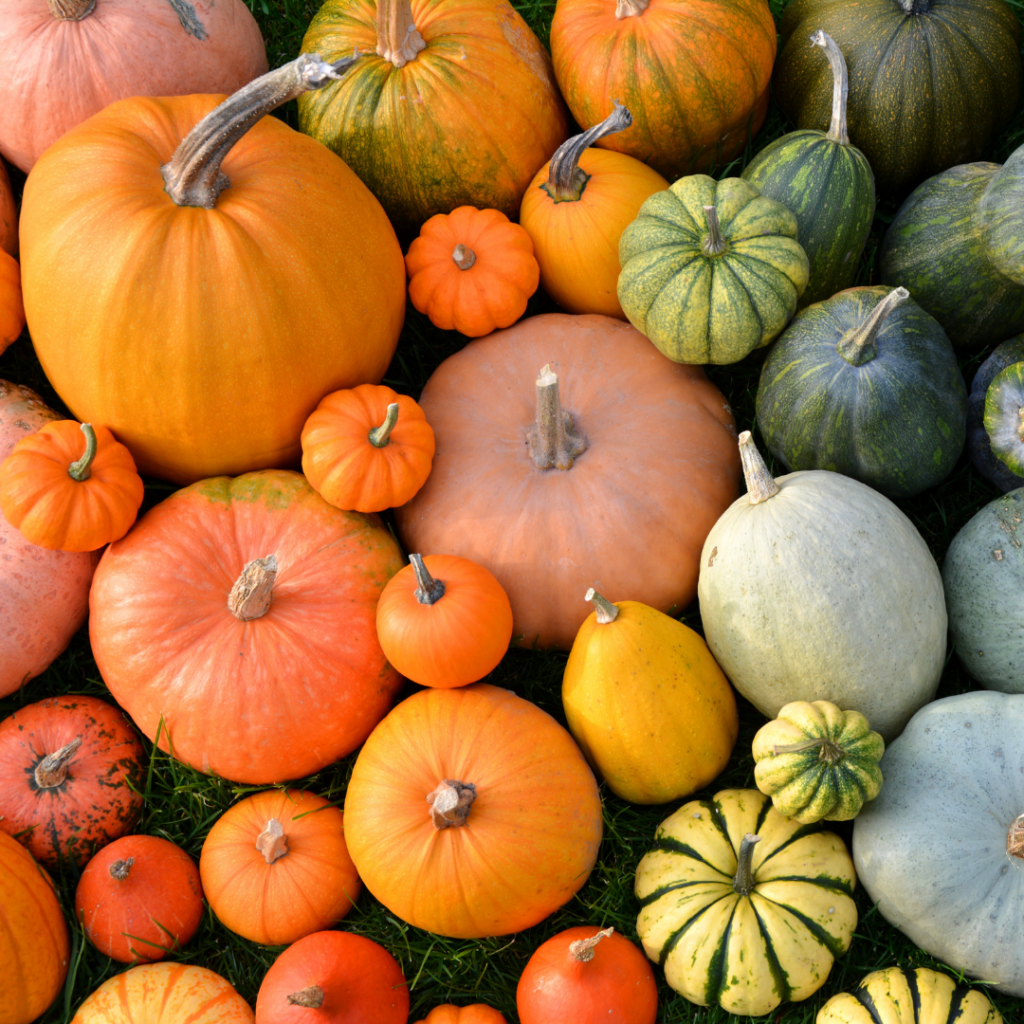
To make sure you’re picking a ripe pumpkin that’s ready for eating, look for the following markers (2):
- Avoid choosing a pumpkin with any soft spots (these spread).
- Look for insect holes to ensure you won’t get any surprises when you carve it!
- Choose one that is heavy for its size (pick up a few of about the same size to compare) because this means it has more sweet flesh inside for cooking.
Choosing a pumpkin is very similar to choosing other types of squash, like butternut squash, and they can be cooked similarly as well.
Fun fact
Fun fact
Pumpkin is a type of squash in the same family as butternut squash, acorn squash, spaghetti squash, and zucchini.
You’ll often hear pumpkin referred to as a “winter” squash – winter squash like pumpkin tends to have a much thicker rind and more dense flesh compared to summer squash (3).
Is canned pumpkin ok for babies?
Yes, it is!
If using canned pumpkin puree, make sure you purchase “pure pumpkin” where pumpkin is the only ingredient, not pumpkin pie filling. We recommend avoiding anything that is labelled as pumpkin pie filling because it typically contains added sugar, sodium, or other preservatives.
We also recommend searching for a BPA-free can of pumpkin, if possible.
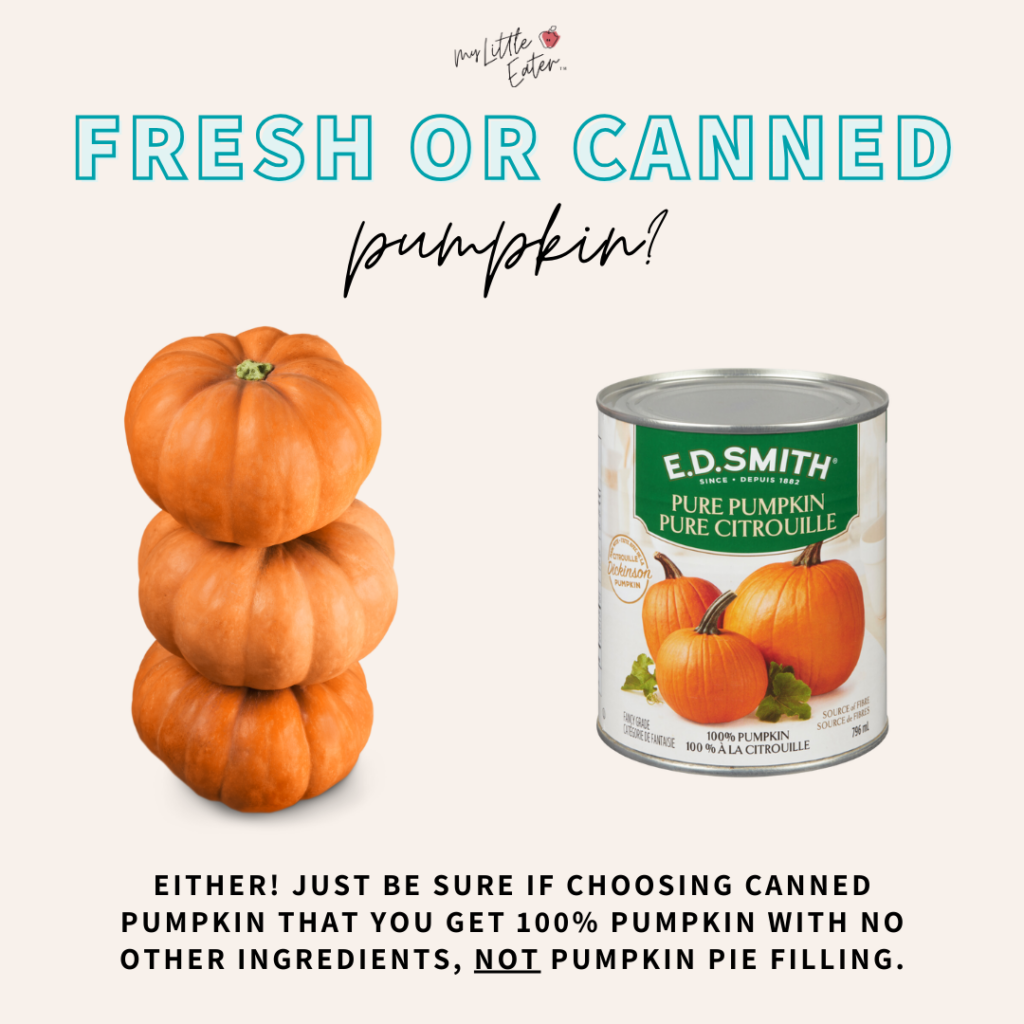
Of course, this will only be helpful if using pumpkin in a recipe – we get it roasting a pumpkin for pumpkin pancakes may not be the easiest way to go! Or if your baby is still on a phase 0 or phase 1 texture.
Canned pumpkin is naturally more of a phase 1 texture on our Texture Timeline™ because of its thickness, but you can thin it out slightly with some breastmilk or formula for a phase 0 texture.
Preparing a fresh pumpkin for cooking
Wash
The very first step is always to thoroughly wash your produce before cutting it. You can clean it by rinsing it underwater and gently rubbing the skin with your hands or a produce brush to remove any residue.
Remove seeds
Cut in a circle around the stem to remove the top of the pumpkin and scoop out the seeds. We recommend using a large, metal spoon for scooping so that you can scrape as much of the thin threads out before cooking the flesh.

You can also save the seeds to roast for yourself if you’d like. Plus, pumpkin seed butter is a great option for putting on toast for your baby. So if you love to cook, saving the seeds to make something like that could be worth it!
Cut in sections
You can either cut the pumpkin into large sections to roast it in the oven or even boil it on the stove. Or you can keep the pumpkin whole and place it in a casserole dish to roast standing up (this works well if you’re roasting more than one in the dish so they don’t fall over). Either way, it’s easiest to leave the skin on until the pumpkin is roasted if you’re planning to puree it, then scoop out the flesh afterward.
If you want to serve it as a finger food and cut the pumpkin into shapes for your baby to hold, you’ll have to peel the skin off before cooking. Then cut the flesh into the desired shape before roasting it in the oven.
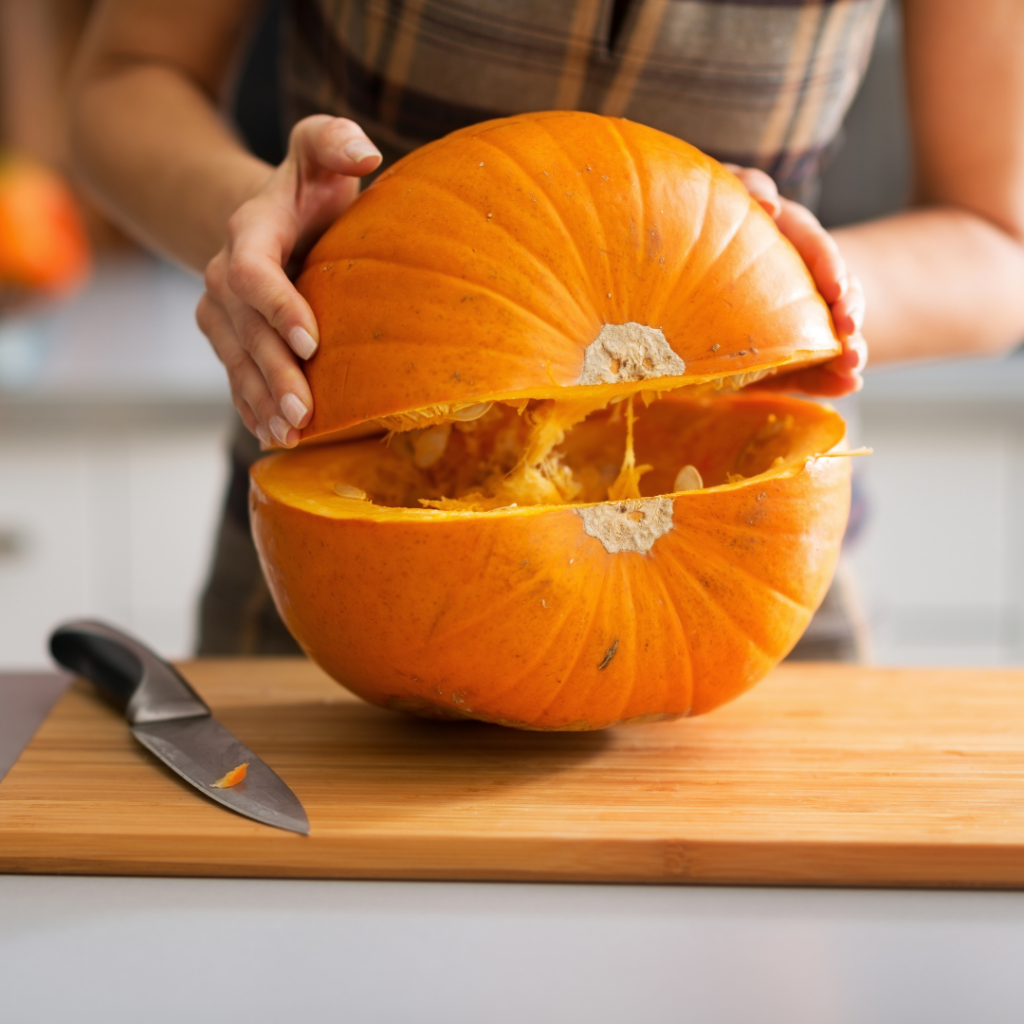
The benefit of roasting is that you can add healthy fat with oil or butter and then also add more flavor by changing up the spices.
Classic options for pumpkin would be cinnamon, nutmeg, garlic powder, or paprika.
Recommended next...
Learn about how to serve other popular fall fruits and vegetables that are perfect for babies.
Shopping in-season is not only cost effective but the produce is likely to be fresher with more flavor!
Storing tips for cooked pumpkin
While whole, uncooked pumpkins can last for months in cool temperatures, and even carved pumpkins can stay fresh for a few weeks, cooked pumpkins are similar to any other cooked food (2).
Once cooked, or after opening a can of pumpkin, it needs to be stored in an airtight container in the fridge and should be used within 5-7 days (4). Alternatively, pumpkin puree (fresh or canned) can be stored in the freezer for up to 3 months with no change in flavor or texture (4).
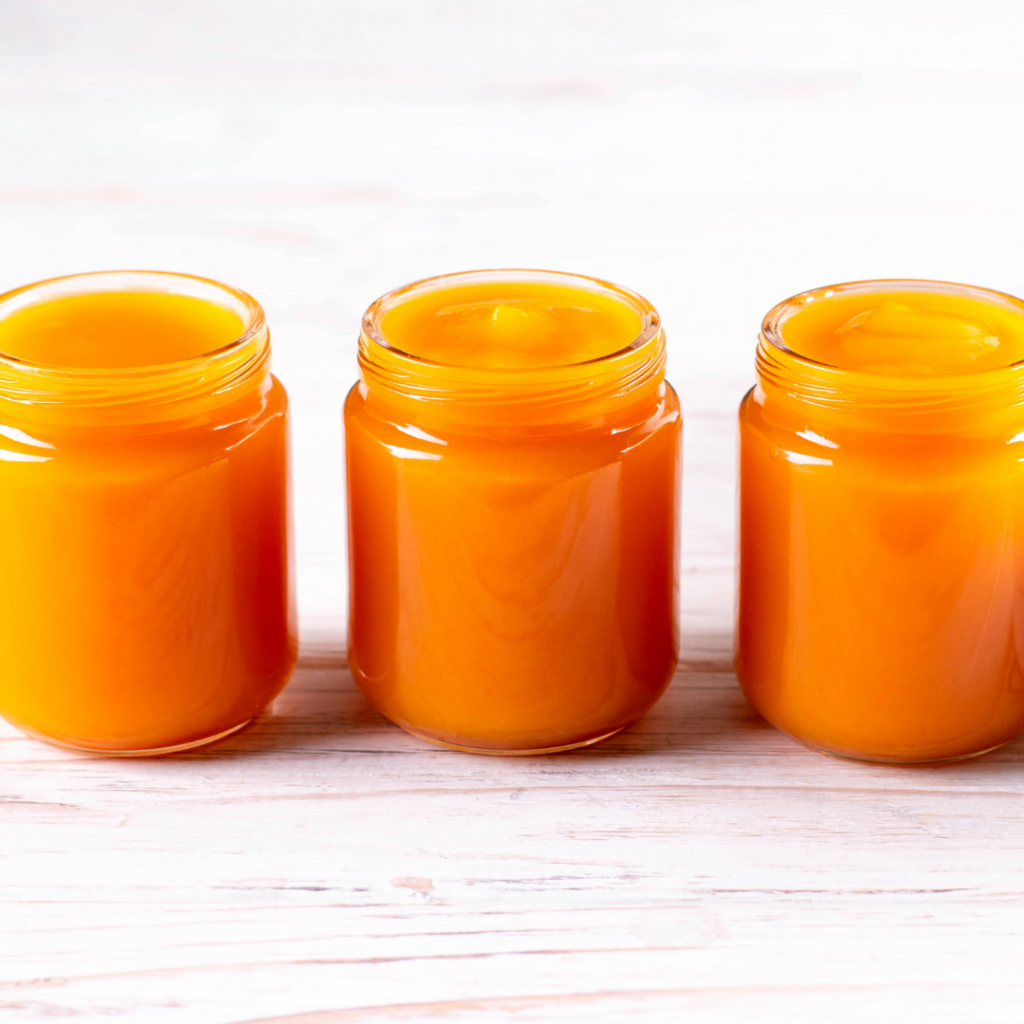
The only exception to this would be if you’ve added breastmilk or formula to the puree for your baby. In this case, you need to review proper storing protocols for breastmilk or formula and follow those best-before dates.
For example, once powdered formula has been mixed, it’s only good for 24 hours so you wouldn’t be able to keep any pumpkin that has formula in it for longer than that.
Nutritional information
Thanks to its vibrant orange color, pumpkin is an excellent source of beta-carotene which acts as an antioxidant in the body (1). Beta-carotene is also a precursor to vitamin A – an important nutrient for eye health (5,6).
Pumpkin also provides small amounts of other essential nutrients like potassium, phosphorus, fiber, and antioxidant vitamins C and E which can help to support immune function and protect against cell damage (1,7).
Overall, pumpkin is an excellent, nutritious food to add to your baby’s diet!
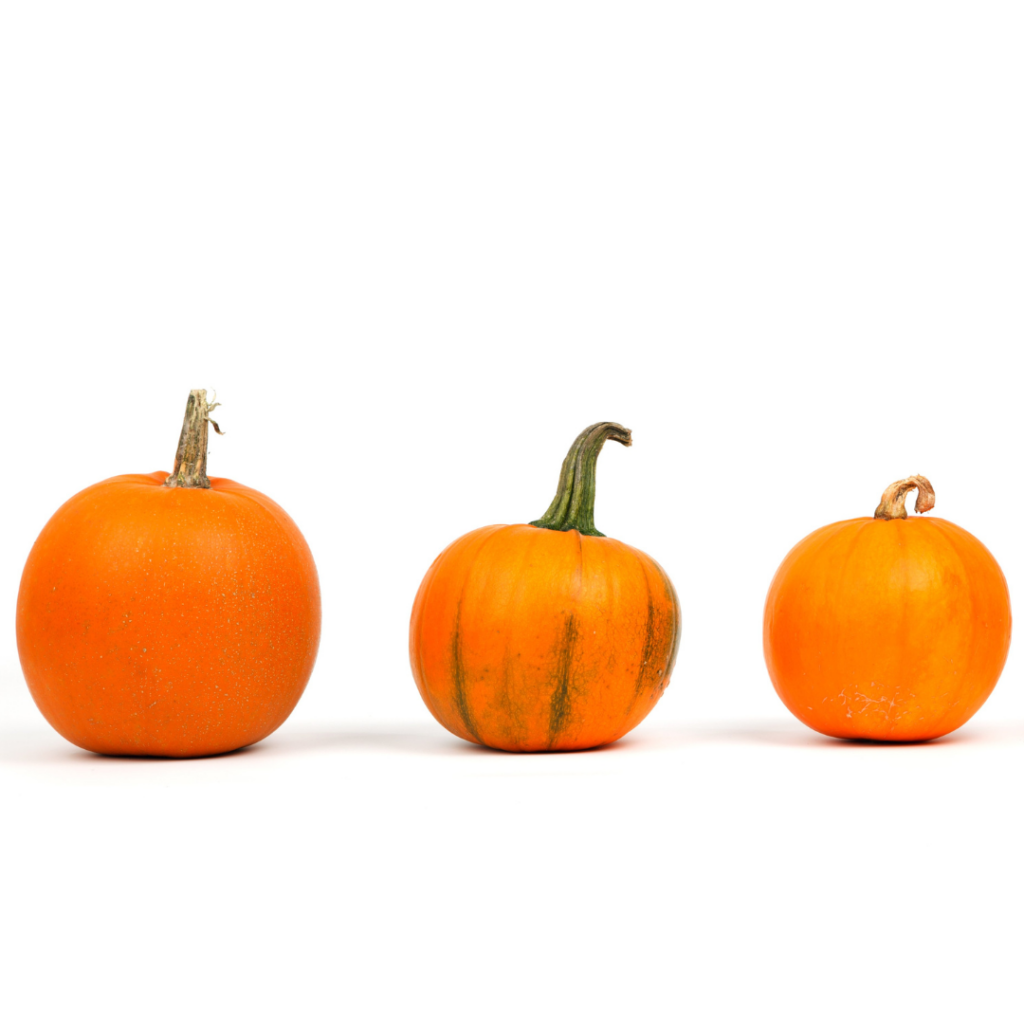
Can babies be allergic to pumpkins?
Pumpkin is not one of the top 10 highly allergenic foods.
That said, while an allergy to pumpkin is rare, it’s not impossible. Pumpkin can be a trigger for Food Protein-Induced Enterocolitis Syndrome (FPIES) which is characterized by a sensitivity to the protein in certain foods (8, 9).
Symptoms of FPIES include excessive vomiting, diarrhea, lethargy, and dehydration within 1-3 hours of ingesting the trigger food (10). FPIES is most common during infancy, and luckily, most infants grow out of it by around age five (9).
If you suspect that your baby has an allergy, it’s best to consult with your doctor for appropriate treatment, diagnosis, and medical advice. Discontinue offering the suspected allergenic food until you receive direction from your doctor regarding the next steps.
To get full access to our Texture Timeline™ Food Video Library so you can search any food and find out important nutrition and allergy info, plus how to safely serve it, check out our Baby Led Feeding Program.
In addition to getting lifetime access to all of our video teachings and printable resources for starting solids so you can feed your baby with confidence, you’ll also get lifetime access to the video library and ongoing support from the My Little Eater team!
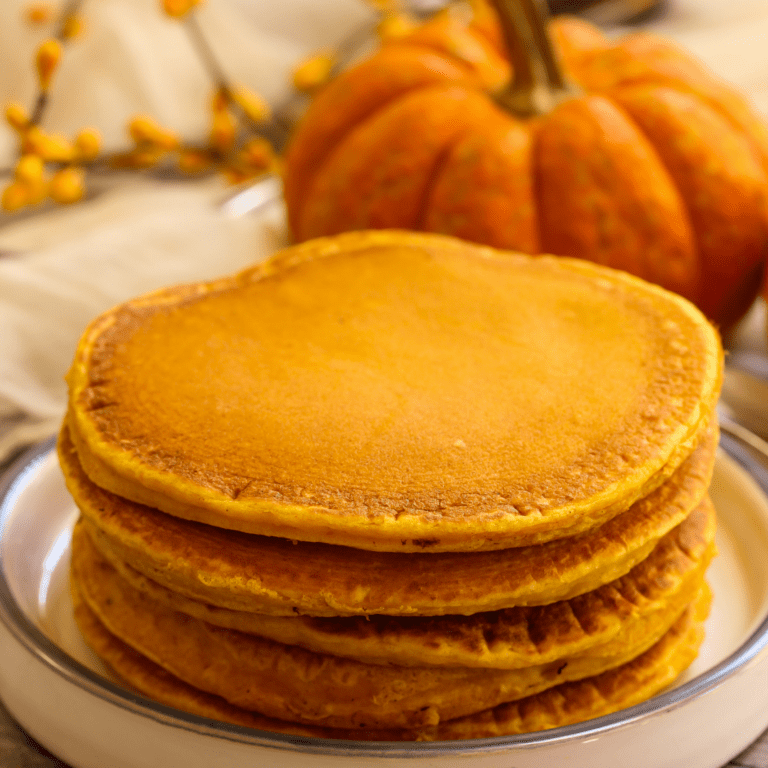
Pumpkin Pancakes
Equipment
- skillet
Ingredients
- 2 eggs
- ¾ cup pumpkin puree
- ⅔ cup unsweetened vanilla oat milk
- 2 tsp vanilla extract
- 1 ½ cups oats
- 2 tsp baking powder
- 1 tsp ground cinnamon
- ½ tsp allspice
- ½ tsp nutmeg
- ½ tsp ground ginger
- Coconut oil for cooking
Instructions
- Preheat non-stick skillet on medium heat. Melt small amount of coconut oil in the pan.
- Combine all ingredients (excluding the coconut oil) in a blender and blend until mixed.
- Pour 2-3 tablespoons of batter on the skillet for each pancake, and cook for 2-3 minutes on each side, or until the batter bubbles through. Let cool slightly. Cut into 3-4 inch long strips (about 1 inch wide).
- Plate pancake fingers. Enjoy!
Notes
Pin it to save the info for later!

References
- U.S. Department of Agriculture. (2019). Pumpkin, cooked, boiled, drained, without salt. https://fdc.nal.usda.gov/fdc-app.html#/food-details/168449/nutrients
- https://www.mccormick.com/articles/mccormick/pumpkin-picking-guide–top-pumpkin-recipes
- Jacob, R. A., & Sotoudeh, G. (2002). Vitamin C function and status in chronic disease. Nutrition in clinical care : an official publication of Tufts University, 5(2), 66–74. https://doi.org/10.1046/j.1523-5408.2002.00005.x
- https://www.thekitchn.com/how-long-does-pumpkin-puree-last-263168
- Lu, W., Shi, Y., Wang, R., Su, D., Tang, M., Liu, Y., & Li, Z. (2021). Antioxidant Activity and Healthy Benefits of Natural Pigments in Fruits: A Review. International journal of molecular sciences, 22(9), 4945. https://doi.org/10.3390/ijms22094945
- Johra, F. T., Bepari, A. K., Bristy, A. T., & Reza, H. M. (2020). A Mechanistic Review of β-Carotene, Lutein, and Zeaxanthin in Eye Health and Disease. Antioxidants (Basel, Switzerland), 9(11), 1046. https://doi.org/10.3390/antiox9111046
- Harvard School of Public Health. (2024). The Nutrition Source: winter squash. https://nutritionsource.hsph.harvard.edu/food-features/winter-squash/
- Lange, L., Gernert, S., Berger, M., Arens, A., Rache, L., Delissen, J., Yavuz, S. T., Millner-Uhlemann, M., Wiesenäcker, D., Neustädter, I., Reese, I., Utz, P., Schuster, A., Adelsberger, D., Ziegert, M., Kerzel, S., & Finger, A. (2022). Different Patterns of Foods Triggering FPIES in Germany. The journal of allergy and clinical immunology. In practice, 10(4), 1063–1069. https://doi.org/10.1016/j.jaip.2021.11.033
- Caubet, J.C., Ford, L.S., Sickles, L., Järvinen, K.M., Sicherer, S.H., Sampson, H.A., & Nowak-Węgrzyn, A. (2014). Clinical features and resolution of food protein–induced enterocolitis syndrome: 10-year experience, Journal of Allergy and Clinical Immunology, 134(2), 382-389.e4. https://doi.org/10.1016/j.jaci.2014.04.008
- Feuille, E., & Nowak-Węgrzyn, A. (2015). Food Protein-Induced Enterocolitis Syndrome, Allergic Proctocolitis, and Enteropathy. Current allergy and asthma reports, 15(8), 50. https://doi.org/10.1007/s11882-015-0546-9

Bianca Gruenewald, RD
Bianca is a Registered Dietitian and works in a client support role at My Little Eater Inc. She's a proud auntie to her three year old niece and four year old nephew!

Bianca Gruenewald, RD
Bianca is a Registered Dietitian and works in a client support role at My Little Eater Inc. She's a proud auntie to her three year old niece and four year old nephew!
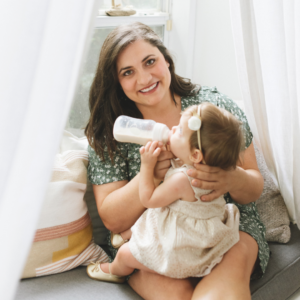
Mallory Roberts, SLP
Mallory is a Speech-Language Pathologist, Infant Feeding Specialist, and Craniosacral Therapist. She's also a busy mom of four little ones!

Mallory Roberts, SLP
Mallory is a Speech-Language Pathologist, Infant Feeding Specialist, and Craniosacral Therapist. She's also a busy mom of four little ones!
